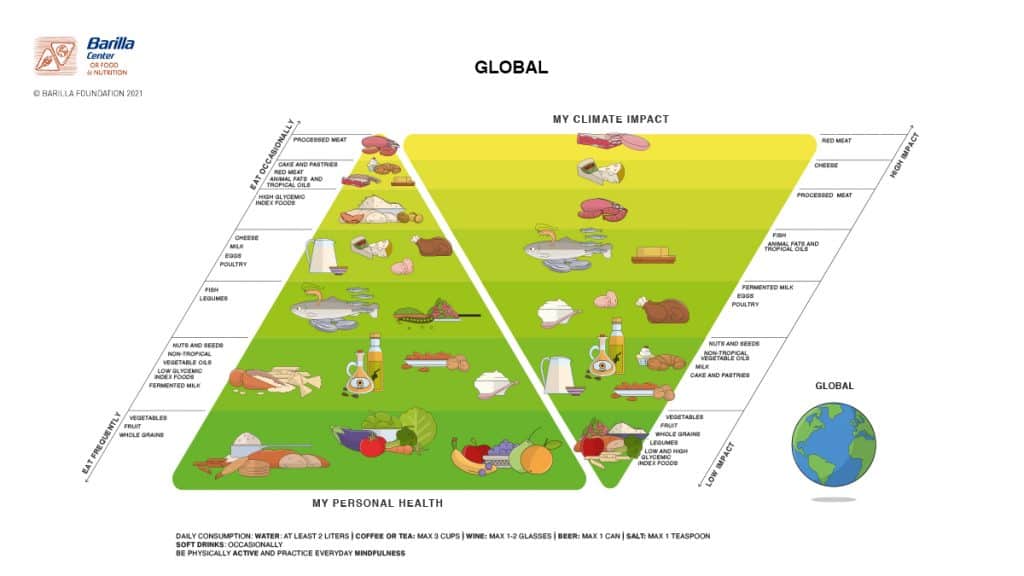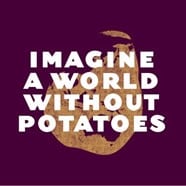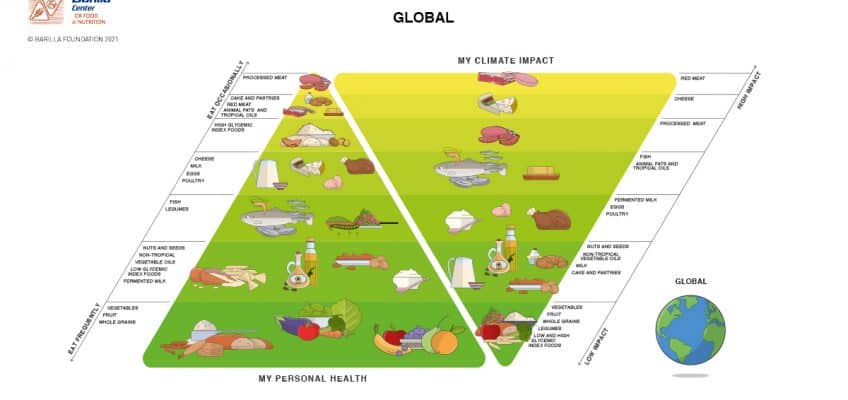This World Potato Market article is republished with permission from Cedric Porter , Editor and Chief of the WPM report. He wrote this for the World Potato Congress in response to an EAT-Lancet report from, which can be found here https://eatforum.org/eat-lancet-commission/eat-lancet-commission-summary-report/
The key takeaway for NZ Potato Industry is that potatoes will play a major role in helping sustainably feed Aotearoa and the world, using less resources and requiring less land.
Nutritional value per hectare is key. The high yields per hectare of potatoes make spuds an impressive food staple. Potatoes are low in calories, high in fibre, a source of protein and loaded with vitamins like Vitamin C and potassium.
Potatoes score very well on environmental impact, producing less CO2, lower nitrate leaching and requiring less water to produce than legumes, wheat, or rice. Spuds also require less area to grow, and 5kg can be produced in 1m², about ¼ of the area for equivalent in rice and much less than needed to produce a kilogram of legumes.
The Barilla Center’s (sic) double food pyramid depicts the nutritional value of food and its environmental impact, with potatoes appearing in the base layer of the nutrition pyramid denoting high nutritional value and in the tip of the environmental pyramid denoting low impact.
New ‘sustainable’ diet underestimates value of potatoes
A recent report on improving global diets in a sustainable way has gathered a lot of attention, both positive and negative. EAT-Forum advocated a big switch to plant-based foods, but has seemed to overlook the contribution of one of the world’s most versatile, nutritious and sustainable foods – the potato.
In the introduction to the Food Planet Health Healthy Diets From Sustainable Food Systems, Prof Walter Willett of the Chan School of Public Health at Harvard University, USA said: “Transformation to healthy diets by 2050 will require substantial dietary shifts. Global consumption of fruits, vegetables, nuts and legumes will have to double, and consumption of foods such as red meat and sugar will have to be reduced by more than 50%. A diet rich in plant-based foods confers both improved health and environmental benefits.”
| EAT Forum recommended healthy diet | ||
| Grams per day | Calories kcal/day | |
| Whole grains – rice, wheat, corn etc | 232 | 811 |
| Starchy veg – Potatoes or cassava | 50 | 39 |
| Vegetables | 300 | 78 |
| Fruits | 200 | 126 |
| Dairy foods | 250 | 153 |
| Protein sources | ||
| Beef, lamb & pork | 14 | 30 |
| Chicken & other poultry | 29 | 62 |
| Eggs | 13 | 19 |
| Fish | 28 | 40 |
| Legumes | 75 | 284 |
| Nuts | 50 | 291 |
| Added fats | ||
| Unsaturated oils | 40 | 354 |
| Saturated oils | 11.8 | 96 |
| Added sugars | 31 | 120 |
| Total | 1.324kg | 2503 |
| Source: EAT Forum |
The report was written with input from 37 scientists from 16 countries. EAT-Forum is a non-profit organisation, supported by the Norwegian Stordalen Environmental Foundation, the Stockholm Resilience Centre and the Wellcome Trust, a medical charity set up by the Wellcome pharmaceutical company. The report came up with a guide to a healthy diet consisting of 2503kcal a day weighing 1.324kg.
As well as a decrease in animal products, the diet focuses on the increase of whole grains, vegetables, fruit and plant-based proteins such as nuts and legumes. However, it also calls for a limit in starchy vegetable intake, namely potatoes and cassava, to just 50g a day.
In the summary report, there is little reason given for the recommended volumes, although it does say they are a guide and there are bound to be variations of ideal diets in different locations across the world.
The diet has attracted criticism from those in the meat and dairy industry, who said that it underestimated the importance of producing meat and milk from grass and the increasingly efficient use of feed and resources. But there has been less attention on the downgrading of potatoes.
There is plenty of evidence that potatoes have a major role to play in producing food which is nutritionally rich as well as environmentally sustainable and efficient. The Chinese and Indian Governments both have programmes to increase the production and consumption of potatoes as pressure on their food supplies increase. Meanwhile, breeding and agronomy programmes run by the International Potato Centre across the world are increasing the yield and nutritional value of potatoes and other crops such as sweet potatoes and cassava.
| Protein and calorie output from key food crops | |||||||
| Tonnes millions | Hectares millions | t/ha | Protein tonnes | Calories trillions | Prot/ha | Cal/ha millions | |
| Maize/corn | 822.7 | 161.0 | 5.1 | 65.8 | 2974 | 0.409 | 18.5 |
| Wheat | 689.9 | 223.6 | 3.1 | 94.5 | 2421 | 0.423 | 10.8 |
| Rice (paddy) | 685.0 | 159.0 | 4.3 | 48.8 | 2356 | 0.307 | 14.8 |
| Potatoes | 314.1 | 18.2 | 17.3 | 6.3 | 240 | 0.345 | 13.2 |
| Cassava | 233.0 | 18.7 | 12.5 | 3.2 | 363 | 0.169 | 19.4 |
| Soybeans | 231.0 | 96.9 | 2.4 | 84.3 | 997 | 0.870 | 10.3 |
| Sugar cane* | 174.3 | 24.4 | 7.2 | 0.0 | 2438 | 0.000 | 100.0 |
| Barley | 157.6 | 56.8 | 2.8 | 19.7 | 558 | 0.347 | 9.8 |
| Sweet pots. | 110.1 | 8.2 | 13.5 | 1.7 | 93 | 0.211 | 11.4 |
| Cabbages | 69.7 | 3.1 | 22.4 | 0.9 | 20 | 0.287 | 6.4 |
| Sorghum | 65.5 | 44.9 | 1.5 | 7.4 | 238 | 0.165 | 5.3 |
| Rape oil | 57.9 | 30.3 | 1.9 | 0.0 | 224 | 0.000 | 7.4 |
| Yams | 51.7 | 4.9 | 10.5 | 0.8 | 60 | 0.161 | 12.1 |
| Sugar beet* | 41.0 | 4.4 | 9.3 | 0.0 | 439 | 0.000 | 100.0 |
| Palm Oil | 38.9 | 9.7 | 4.0 | 0.0 | 344 | 0.000 | 35.4 |
| Groundnuts | 38.2 | 24.6 | 1.6 | 9.9 | 23 | 0.401 | 0.9 |
| Millet | 35.7 | 37.4 | 1.0 | 3.9 | 129 | 0.105 | 3.4 |
| Sunflower | 35.6 | 25.0 | 1.4 | 7.4 | 217 | 0.296 | 8.7 |
| Plantains | 34.3 | 5.4 | 6.4 | 0.4 | 45 | 0.083 | 8.4 |
| Oats | 25.8 | 11.3 | 2.3 | 4.4 | 99 | 0.384 | 8.7 |
| Pumpkins, squash etc | 20.9 | 1.5 | 13.7 | 0.3 | 19 | 0.180 | 12.7 |
| Beans, dry | 20.4 | 28.0 | 0.7 | 4.5 | 64 | 0.160 | 2.3 |
| Broccoli (cauliflower) | 18.0 | 1.1 | 17.0 | 0.5 | 7 | 0.478 | 6.7 |
| Rye | 17.8 | 6.8 | 2.6 | 1.8 | 62 | 0.271 | 9.1 |
| Triticale | 14.0 | 3.9 | 3.6 | 1.8 | 49 | 0.470 | 12.6 |
| Tree Nuts | 12.2 | 8.7 | 1.4 | 2.1 | 0 | 0.243 | 0.0 |
| Taro (cocoyam) | 11.8 | 1.6 | 7.2 | 0.2 | 0 | 0.109 | 0.0 |
| Peas, dry | 9.8 | 5.9 | 1.7 | 1.7 | 0 | 0.289 | 0.0 |
| Chick peas | 8.8 | 11.6 | 0.8 | 1.7 | 0 | 0.147 | 0.0 |
| Peas, green | 8.3 | 1.1 | 7.4 | 0.5 | 0 | 0.400 | 0.0 |
| Beans, snap | 6.8 | 1.0 | 6.9 | 0.1 | 0 | 0.127 | 0.0 |
| Note: * refined sugar. Source: EAT Forum |
The report has judged foods on their protein and calorific value. However, the more important calculation of calories or protein per hectare appears to have been ignored. Using that calculation, potatoes deliver more protein per hectare than rice and a similar amount as barley – both grains which EAT Forum promotes more consumption of. The high yields of potatoes and cassava mean that they also deliver large amounts of calories per hectare. In fact, cassava has the highest calorie per hectare rate of any food aside from sugar crops or palm oil at 19.4 million calories per hectare.
Nutritional value per hectare or acre is a key calculation
Analysis of other data, not published by EAT Forum, would also suggest that the protein and calorie value of potatoes have been underestimated in the research. The USDA says potatoes have 2.05g of protein per 100g. Using EAT Forum’s average global yield of 17.3t/ha, the volume of protein produced per hectare of potatoes would be 354kg/hectare. The latest UN FAOSTAT average global potato yield for 2017 is 20.33 tonnes/hectare, which delivers 417kg/hectare of protein.
The USDA calculates that the protein content of long-grain white rice is 2.69g/100g. That would deliver 115.9Kg of protein per hectare, according to EAT Forum’s average yield of 4.3t/ha. The latest average global rice yield is 4.5t/ha, according to the UN FAOSTAT, which would deliver 124kg of protein.
The USDA also states that 100g of potatoes delivers 77 calories/100g, while rice delivers 130 calories/100g. On an area basis that equals 15.6 million calories per hectare for potatoes and 5.98 million calories per hectare for rice. Potatoes score well on a protein basis when compared with a selection of grains and a pulse, with only sweet potatoes and corn scoring higher. Corn and sweet potatoes also score higher on a calories/hectare basis. Potatoes also have a significantly higher potassium content than any of the other foods and a much higher Vitamin C content. The calcium content of sweet potatoes is a little higher than potatoes.
EAT Forum urges people to eat a lot more pulses. It is true that on a kilogram basis a pulse such as lentils delivers a lot more protein and is high in calories, potassium and calcium compared to grains and tubers, but its low yields mean that on a per hectare basis it is a lot less impressive. It is this nutrients per hectare calculation that the EAT Forum report appears to ignore, largely focusing on nutritional value per tonne.
There is the potential for potatoes to be even more nutritionally valuable. The EAT Forum figures are based on average global yields. However, potato growers across the world can achieve yields of above 40 tonnes/hectare, with the record at more than 70 tonnes/hectare. That compares with a rice world record yield of 17 tonnes/hectare.
| Calculated protein, calorie and mineral value of key crops by hectare | ||||||
| Protein/100g | Calories/100g | Potassium mg/100g | Calcium mg/100g | Vit C mg/100g | Av yield | |
| Corn (yellow grain) | 9.42 | 365 | 287 | 7 | 0 | 5.7 |
| Wheat flour/whole | 9.6 | 332 | 394 | 33 | 0 | 3.5 |
| Rice | 2.69 | 130 | 35 | 10 | 0 | 4.6 |
| Potatoes | 2.05 | 77 | 425 | 12 | 19.7 | 20.3 |
| Cassava | 1.36 | 160 | 271 | 16 | 20.6 | 11.1 |
| Sweet potatoes | 4.0 | 200 | na | 20 | 0 | 12.3 |
| Lentils | 24.6 | 352 | 677 | 35 | 4.5 | 1.1 |
| Prot kg/ha | Cal/ha | Potassium mg/ha | Calcium mg/ha | Vitamin C mg/ha | ||
| Corn (yellow grain) | 0.537 | 20.805 | 16.359 | 0.399 | 0.000 | |
| Wheat flour/whole | 0.336 | 11.62 | 13.79 | 1.155 | 0.000 | |
| Rice | 0.124 | 5.98 | 1.61 | 0.46 | 0.000 | |
| Potatoes | 0.416 | 15.631 | 86.275 | 2.436 | 3.999 | |
| Cassava | 0.151 | 17.76 | 30.081 | 1.776 | 2.287 | |
| Sweet potatoes | 0.492 | 24.6 | na | 2.46 | 0.000 | |
| Lentils | 0.271 | 3.872 | 7.447 | 0.385 | 0.050 | |
| Note: Calculated using USDA data. https://ndb.nal.usda.gov/ndb/search/list Highest scoring food in bold |
Environmental value of potatoes
The report is not just looking at the nutritional value of food, but also its environmental impact. Again, the EAT Forum report appears to underestimate the value of potatoes and the importance of yield. A recent study Oxford University (see here: https://josephpoore.com/) into the environmental impact of certain foods was used by the BBC to develop a greenhouse gas calculator. eating two small potatoes three to five time a week results in annual greenhouse gas emissions of 9kg a year. That compares to 69kg for rice, 25kg for pasta, 22kg for oatmeal and 12kg for bread. The calculator can be found here: https://www.bbc.co.uk/news/science-environment-46459714
Potatoes also score very well in extensive work into the environmental impact by the Barilla Center For Food & Nutrition. It calculates that the CO2 emission of potatoes is 1 205g per kilogram produced, which compares to 1 050g for bread, 1 660g for legumes, 2 155g for pasta and 3 755g for rice. When it comes to water, potatoes use 55 litres for every kilogram produced. Only general vegetables are less thirsty at 335l. Bread uses 1 170l/kg, pasta 1 775l, rice 2 585l and legumes 2 710l.
It takes just 5m² to produce a kilogram of potatoes, half the area of rice and just 28% of the land needed to produce a kilogram of legumes. Barilla have visualised the nutritional value of food and its environmental impact in a double pyramid, with potatoes appearing in the second layer of the nutrition pyramid denoting high nutritional value and in the point of the environmental pyramid denoting low impact. The research can be found here: https://www.fondazionebarilla.com/en/publications/
| Environmental impact of key foods | |||
| Water use l/kg | g of CO2/kg/l | m² of land/kg | |
| Beef | 18800 | 25895 | 146 |
| Poultry | 4805 | 4040 | 44 |
| Cheese | 6260 | 9250 | 61 |
| Milk | 1330 | 1255 | 8 |
| Legumes | 2710 | 1660 | 18 |
| Rice | 2585 | 3745 | 10 |
| Pasta | 1775 | 2155 | 12 |
| Bread | 1170 | 1050 | 7 |
| Fruit | 930 | 490 | 4 |
| Potatoes | 555 | 1205 | 5 |
| Vegetables | 335 | 775 | 3 |
| Source: Barilla Center for Food & Nutrition |

Affordability is another key factor
There is little focus on affordability in the EAT Forum report, but that is important in a world where nearly half of people live on less than US$5.50 a day, according to latest World Bank figures. Analysis by the Alliance for Potato Research & Education in 2013 found that potatoes and beans were the least expensive sources of potassium and fibre, with white potatoes almost half the cost of most other vegetables by volume. See https://apre.org/potato-nutrition/nutrition-facts/ for more.
The EAT Forum report has set out five strategies for improving sustainable diets. They are:
- Seek international and national commitment to shift toward healthy diets
- Reorient agricultural priorities from producing high quantities of food to producing healthy food
- Sustainably intensify food production to increase high-quality output
- Strong and coordinated governance of land and oceans
- At least halve food losses and waste, in line with UN Sustainable Development Goals

Aside from the fact that the world needs to produce large quantities of healthy food, these five facts will make a lot of sense to anyone in the food industry. If they are to be achieved, then improved production of all crops will be necessary. Underestimating or even excluding any of them does not make sense, particularly when it is a crop such as the potato which has such a role to play. The EAT Forum report is here: https://eatforum.org/
The potato industry is being urged to come together to celebrate and promote the nutritional and environmental role of the potato under the banner of the Internal Potato Center’s Imagine a World Without Potatoes campaign. See https://worldwithoutpotatoes.org/ for more.
World Potato Markets
This article originally appeared in World Potato Markets, the weekly global information service on production, trade and price of potatoes and potato products. For more see www.worldpotatomarkets.com or contact editor Cedric Porter at prqevp@fhccylvagryyvtrapr.pb.hx or call 0044 1892 543444.


World Potato Markets is a sustaining partner of the World Potato Congress.



